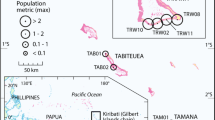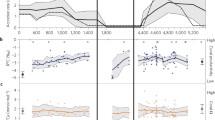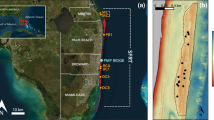Abstract
The findings in this paper show that Arabian Gulf (Abu Dhabi, Dubai, Sharjah) corals have already been measurably affected by climate change and further negative impacts are expected. Corals in South Africa have been only weakly impacted and are expected to persist in this likely refuge. The Arabian Gulf has recently experienced high-frequency recurrences of temperature-related bleaching (1996, 1998, 2002). First evidence may suggest that bleaching patterns in corals changed due to phenotypic adaptation after two strong bleaching events in rapid succession, because Acropora, which during the 1996 and 1998 events always bleached first and suffered heaviest mortality, bleached less than all other corals in 2002 at Sir Abu Nuair and recovered at Jebel Ali and Ras Hasyan. In South Africa, reef corals largely escaped the mass mortalities observed across the tropics in the late 1990s, although bleaching has also increased since 1999. These reefs are protected by local small-scale upwelling events in summer that, if they occur at the right time, keep temperatures below bleaching levels. Both areas, the Arabian Gulf and South Africa, have rich coral faunas but little to no recent reef-framework production. It is possible that many reefs worldwide may have similar dynamics in the future, if the changed climate (recurrence of temperature anomalies, changes in aragonite saturation state, etc.) suppresses sustained reef building at least temporarily. Global climate models predict the possibility of significant environmental changes, including increases in atmospheric temperature, sea-surface temperature (SST), and sea level. Monsoon and El Niño Southeastern Oscillation (ENSO) patterns might change, but climate models are not conclusive. Sea-level rise by up to 0.88 m is expected to be a problem in some low-lying areas, like the southern Arabian Gulf. Ocean aragonite saturation state is predicted to fall throughout the ocean but may not change reef dynamics in the two study areas.











Similar content being viewed by others
References
Angel MV, Baars MA, Barber RT, Chavez FP, Kastner M, Leinen M, Lutjeharms JRE, Reverdin G, Shimmield GB (1994) Group report: how do open ocean upwelling systems operate as integrated physical, chemical, and biological systems and influence the geological record? In: Summerhayes CP, Emeis K-C, Angel MV, Smith RL, Zeitschel B (eds) Upwelling in the ocean: modern processes and ancient records. Wiley, Chichester, pp 193–219
Baker AC (2001) Reef corals bleach to survive change. Nature 411:765–766
Baker AC, Starger CJ, McClanahan TR, Glynn PW (2002) Symbiont communities in reef corals following the 1997–98 El Niño—will recovering reefs be more resistant to a subsequent bleaching event? In: Proc Int Soc Reef Studies Eur Meeting, Cambridge, Sept, Abstr vol 10
Bottomley N (1996) Recent climate of Abu Dhabi. In: Osborne PE (ed) Desert ecology of Abu Dhabi. A review and recent studies. Pisces, Newbury, pp 36–49
Brown BE, Downs CA, Dunne RP, Gibb SW (2002) Exploring the basis of thermotolerance in the reef coral Goniastrea aspera. Mar Ecol Progr Ser 242:119–129
Buddemeier RW (2001) Is it time to give up? Bull Mar Sci 69(2):317–326
Buddemeier RW, Fautin DG (1993) Coral bleaching as an adaptive mechanism: a testable hypothesis. Bioscience 43:209–216
Celliers L, Schleyer MH (2002) Coral bleaching on high-latitude marginal reefs at Sodwana Bay, South Africa. Mar Poll Bull 44:1380–1387
Clarke KR, Gorley RN (2001) Primer v5: user manual/tutorial. Primer-e, Plymouth, 91 pp
Clarke KR, Warwick RM (2001) Change in marine communities: an approach to statistical analysis and interpretation, 2nd edn. Primer-e, Plymouth, 250 pp
Coles SL, Fadlallah YH (1991) Reef coral survival and mortality at low temperatures in the Arabian Gulf: new species-specific lower temperature limits. Coral Reefs 9:231–237
Copper P (1994) Ancient reef ecosystem expansion and collapse. Coral Reefs 13:3–12
Downing N (1985) Coral reef communities in an extreme environment: the northwestern Arabian Gulf. Proc 5th Int Coral Reef Congr Tahiti (6):343–348
Fabricius KE (1995) Slow population turnover in the soft coral genera Sinularia and Sarcophyton in mid- and outer-shelf reefs of the Great Barrier Reef. Mar Ecol Progr Ser 126:145–152
Fadlallah YH, Allen KW, Estudillo RA (1995) Mortality of shallow reef corals in the western Arabian Gulf (Saudi Arabia). Bull Mar Sci 59:209–216
Floros CD (2002) Bleaching and polychaete loading of coral at Sodwana Bay. MSc Thesis, University of Natal, 74 pp
George JD, John DM (1999) High sea temperatures along the coast of Abu Dhabi (UAE), Arabian Gulf—their impact upon corals and macroalgae. Reef Encounter 25:21–23
George JD, John DM (2000a) The effects of the recent prolonged high seawater temperatures on the coral reefs of Abu Dhabi (UAE). In: Proc Int Symp on Extent of Coral Bleaching, pp 28-29
George JD, John DM (2000b) The coral reefs of Abu Dhabi, United Arab Emirates: past, present and future. In: Proc 2nd Arab Int Conf Exhib Environment Biotechnol (Coastal Habitats), Abu Dhabi, 33 pp
George JD, John DM (2002) Is it curtains for coral reefs in the southern Arabian Gulf? In: Proc Int Soc Reef Studies Eur Meeting, Cambridge, Sept, Abstr vol 36
Glennie KW (1996) Geology of Abu Dhabi. In: Osborne PE (ed) Desert ecology of Abu Dhabi. A review and recent studies. Pisces, Newbury, pp 16–35
Glynn PW (1996) Coral reef bleaching: facts, hypotheses and implications. Global Change Biol 2:495–509
Glynn PW, Colley SB (eds) (2001) A collection of studies on the effects of the 1997–98 El Niño-Southern Oscillation event on corals and coral reefs in the eastern tropical Pacific. Bull Mar Sci 69(1):1–288
Goreau T, McClanahan T, Hayes R, Strong A (2000) Conservation of coral reefs after the 1998 global bleaching event. Cons Biol 14(1):5–15
Holt Titgen R (1982) The systematics and ecology of the decapods, and their zoogeographic relationship to the Arabian Gulf and the western Indian Ocean. PhD Diss, Texas A7 M University, 291 pp
Houghton JT, Ding Y, Griggs DJ, Noguer M, van der Linden PJ, Dai X, Maskell K, Johnson CA (2001) Climate change 2001: the scientific basis. Cambridge University Press, Cambridge, 881 pp
Huckleberry GA (2002) Laminated sediments associated with archeological structures in north coastal Peru: a record of prehistoric El Niño activity. In: Proc Geological Society of America Annual Meeting, Denver, Abstr 159-10
Johnson CR, Dunstan PK, Hoegh-Guldberg O (2002) Predicting the long term effects of coral bleaching and climate change on the structure of coral communities. In: Proc Int Soc Reef Studies Eur Meeting, Cambridge, Sept, Abstr vol 50
Jordan IE, Samways MJ (2001) Recent changes in the coral assemblages composition of a South African coral reef, with recommendations for long-term monitoring. Biodiversity Cons 10(7):1027–1037
Kinsman DJJ (1964) Reef coral tolerance of high temperatures and salinities. Nature 202:1280–1282
Klaus R, Turner J (2002) Upwelling refugia in times of environmental stress. In: Proc Int Soc Reef Studies Eur Meeting, Cambridge, Sept, Abstr vol 52
Kleypas JA, Buddemeier RW, Archer D, Gattuso J-P, Langdon C, Opdyke BN (1999) Geochemical consequences of increased atmospheric carbon dioxide on coral reefs. Science 284:118–120
Kruskal JB (1964) Multidimensional scaling by optimizing goodness of fit to a non-metric hypothesis. Psychometrica 29:1–27
Larcombe P, Ridd PV, Prytz A, Wilson B (1995) Factors controlling suspended sediment on inner-shelf coral reefs, Townsville, Australia. Coral Reefs 14:163–171
Lardner RW, Al-Rabeh AH, Gunay N, Hossain M, Reynolds RM, Lehr WJ (1993) Computation of the residual flow in the Gulf using the Mt Mitchell data and the KFUPM/RI hydrodynamic models. Mar Pollut Bull 27:61–70
Loschnigg S, Meehl GA, Webster PJ, Arblaster JM, Compo GP (2003) The Asian Monsson, the Tropospheric Biennist Oscillation, and the Indian Ocean Zonal Mode in the NCAR CSM. J Climate 16:1617–1642
Lough JM (2000) 1997–8: Unprecedented thermal stress to coral reefs? Geophys Res Lett 27(23):3901–3904
Lutjeharms JRE, Cooper J, Roberts M (2000) Upwelling at the inshore edge of the Agulhas current. Cont Shelf Res 20:1907–1939
Murty TS, El Sabh MI (1984) Storm tracks, storm surges and sea state in the Arabian Gulf and the Gulf of Oman. In: Oceanographic modeling of the Kuwait Action Plan Region. UNESCO, Paris
Nakamura T, Yamasaki M, van Woesik R (2003) Water flow facilitates recovery from bleaching in the coral Stylophora pistillate. Mar Ecol Progr Ser 256:287–291
Neumann AC, Macintyre IG (1985) Response to sea-level rise: keep-up, catch-up or give-up. Proc 5th Int Coral Reef Congr Tahiti 3:105–110
Pfeiffer M, Dullo WC, Eisenhauer A (2001) Indian Ocean reef corals: evidence for secular changes in monsoon circulation? In: Proc 2001 Margins Meeting, Kiel, Schriften GV, Rep 14, 151 pp
Philander SG (1990) El Niño, La Nina and the Southern Oscillation. Academic Press, San Diego, 293 pp
Purser BH, Evans G (1973) Regional sedimentation along the Trucial coast, SE Persian Gulf. In: Purser BH (ed) The Persian Gulf. Holocene carbonate sedimentation and diagenesis in a shallow epicontinental sea. Springer, Berlin Heidelberg New York, pp 211–232
Ramsey PJ (1989) The occurrence and formation of ladderback ripples in subtidal, shallow-marine sands, Zululand, South Africa. Mar Geol 86:229–235
Ramsey PJ (1994) Marine geology of the Sodwana Bay shelf, South Africa. Mar Geol 120:225–247
Ramsey PJ, Miller WR (2002) Multibeam bathymetric survey defines coelacanth habitat. Hydro Int 6(7):57–59
Rasmusson EM (1991) Observational aspects of ENSO cycle teleconnections. In: Glantz MH, Katz RW, Nicholls N (eds) Teleconnections linking worldwide climate anomalies: scientific base and societal impacts. Cambridge University Press, Cambridge, pp 309–343
Reyes Bonilla H (2001) Effects of the 1997–1998 El Niño-Southern Oscillation on coral communities of the Gulf of California, Mexico. Bull Mar Sci 69(1):251–266
Reynolds RW, Smith TM (1994) Improved global sea surface temperature analyses using optimum interpolation. J Climate 7:929–948
Riegl B (1996) Hermatypic coral fauna of subtropical southeast Africa: a checklist. Pac Sci 50(4):404–414
Riegl B (2001) Inhibition of reef framework by frequent disturbance: examples from the Arabian Gulf, South Africa, and the Cayman Islands. Palaeogeogr Palaeoclimatol Palaeoecol 175:79–101
Riegl B (2002) Effects of the 1996 and 1998 sea surface temperature anomalies on corals, fish and coral diseases in the Arabian Gulf (Dubai, UAE). Mar Biol 140:29–40
Riegl B, Piller WE (2003) Possible refugia for reefs in times of environmental stress. Int J Earth Sci (in press)
Roberts HH, Wilson PA, Lugo-Fernandez A (1992) Biologic and geologic responses to physical processes: examples from modern reef systems of the Caribbean-Atlantic region. Cont Shelf Res 12:809–834
Ruddiman WF (2001) Earth’s climate. Past and Future. W.H. Freeman, New York, 465 pp
Sanlaville P (1992) Changements climatiques dans la penisule arabique durant le Pleistocene superieur et lHolocene. Paleorient 18(1):5–26
Savage AM, Trapido-Rosendthal H, Douglas AE (2002) On the functional significance of molecular variation in Symbiodinium, the symbiotic algae of Cnidaria: photosynthetic response to irradiance. Mar Ecol Progr Ser 244:27–37
Schleyer MH (1999) A synthesis of KwaZulu-Natal coral research. SA Assoc Mar Biol Res Spec Publ 5:36
Schleyer MH (2001) A benthic survey of Aliwal shoal and assessment of the effects of wood pulp effluent on the reef. S Afr Assoc Mar Biol Res 187:1–2
Sheppard CRC (2002) Probabilities of repeat episodes of the 1998 mortality in the Indian Ocean. In: Proc Int Soc Reef Studies Eur Meeting, Cambridge, Sept, Abstr vol 148
Sheppard CRC (2003) Predicted recurrences of mass coral mortality in the Indian Ocean. Nature 425:294–297
Sheppard CRC, Price ARG, Roberts CM (1992) Marine ecology of the Arabian region: patterns and processes in extreme tropical environments. Academic Press, London, 257 pp
Sheppard CRC, Wilson SC, Salm RV, Dixon D (2000) Reefs and coral communities of the Arabian Gulf and Arabian Sea. In: McClanahan TR, Sheppard CRC, Obura DO (eds) Coral reefs of the Indian Ocean. Their ecology and conservation. Oxford University Press, Oxford, pp 257–293
Shinn EA (1969) Submarine lithification of Holocene carbonate sediments in the Persian Gulf. Sedimentology 12:109–144
Shinn EA (1976) Coral recovery in Florida and the Persian Gulf. Environ Geol 1:241–254
Stanley GD (ed) (2001) The history and sedimentology of ancient reef ecosystems. Kluwer, Dordrecht, 458 pp
Timmermann A, Oberhuber J, Bacher A, Esch M, Latif M, Roeckner E (1999) Increased El-Niño frequency in a climate model forced by future greenhouse warming. Nature 398:694–696
Wallace CC (1999) Staghorn corals of the world. CSIRO, Collingwood, 421 pp
Wilkinson C (ed) (2000) Status of coral reefs of the world: 2000. Australian Institute for Marine Science, Townsville, 363 pp
Wilson SC (2002) Do seawater temperatures limit coral distribution in southern Arabia? In: Proc Int Soc Reef Studies Eur Meeting, Cambridge, Sept, Abstr vol 10
Wright CI, Miller WR, Cooper JAG (2000) The late Cenozoic evolution of coastal water bodies in northern KwaZulu-Natal, South Africa. Mar Geol 167:207–229
Acknowledgements
This study was funded by NOAA grant NA16OA1443 and Austrian Science Foundation (FWF) grant P13165-GEO while the author worked at NCRI and Karl-Franzens University Graz. Outstanding support by W.E. Piller, H.K. al Shaer, M.A.H. Deshgooni, N.S. al Shaiba, S. Mustafa, M. Samways, C.D. Floros, B. Elliott, S. Purkis, R. Wolcott, R.E. Dodge, J. Korrubel, B. Clarke, and M.E. Schleyer is appreciated. Thanks to N.S. al Shaiba and R. Wolcott for providing photographs. Thanks also to the editors and two anonymous reviewers for tactful and insightful remarks that greatly increased the paper’s quality and style. P. Larcombe and G. Rankey are thanked for final proof-reading and many valuable remarks. J.D. George and D. John are thanked for many valuable discussions. As always, I am deeply indebted to those whose research has paved my way and from whose knowledge I have drawn in this contribution.
Author information
Authors and Affiliations
Corresponding author
Rights and permissions
About this article
Cite this article
Riegl, B. Climate change and coral reefs: different effects in two high-latitude areas (Arabian Gulf, South Africa). Coral Reefs 22, 433–446 (2003). https://doi.org/10.1007/s00338-003-0335-0
Received:
Accepted:
Published:
Issue Date:
DOI: https://doi.org/10.1007/s00338-003-0335-0




